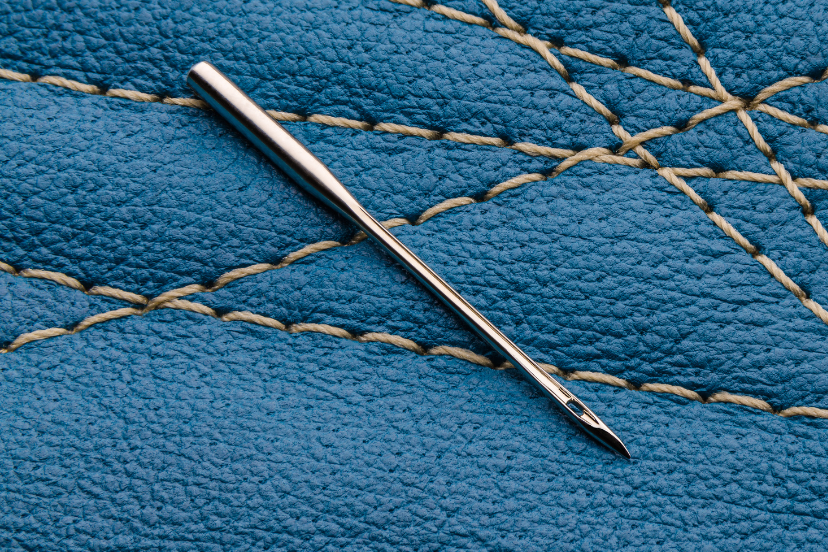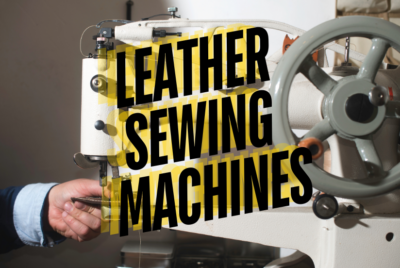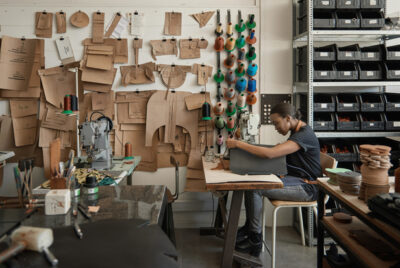Sewing Machine Needles Explained
One essential tool for any sewing project is the needle. The needle is the point of contact for any project you do. Using the correct needle ensures the quality of your work. Heavier material requires a larger needle size. Lighter weight materials should use smaller needle sizes. It’s always best to check the sewing manufacturers needle recommendations.
Here is a sewing machine needle guide to help your search. We cover problems using incorrect sewing needles, the terminology of the parts of the sewing needle, the types of sewing needles, and a list of popular sewing machine brands with sources.
Although lookalike needles might be available, it’s always good to check that they are identical to the needle you are trying to replace. The secret of Singer needles has interesting information comparing a Singer needle to another comparable needle. Sometimes minor differences in manufacturing design can impact how your needle works with your machine.
| Sewing Machine Needle Article Topics |
| Sewing Machine Needle Problems |
| Sewing Machine Needle Parts |
| Sewing Machine Needle Types |
Sewing Machine Needle Problems
Using the incorrect type of sewing machine needle can lead to a variety of problems. Besides affecting the quality of your sewing project, it can also cause other minor damage and affect the longevity of your sewing machine. Here’s a breakdown of the key issues.
Damage to Fabric
- Puckering or Tearing. Using a needle that is too large for the fabric can cause puckering, where the fabric gathers in an unwanted way. A needle that is too sharp or too thick for delicate fabrics like silk or chiffon can even tear the fabric, leaving it ruined.
- Skipped Stitches. If the needle is too small or too blunt for the fabric, it may not penetrate the fabric properly, resulting in skipped stitches. This not only affects the appearance of the seam but also its durability.
- Snagging. Certain fabrics require specific needles. For example, using a universal needle on stretch fabric might cause snagging, as the needle isn’t designed to handle the elasticity of the material.
Thread Breakage
- Incorrect Needle Size. A needle that is too small for the thread can cause the thread to break frequently. This happens because the thread doesn’t have enough room to pass through the eye of the needle smoothly.
- Wrong Needle Type. Using the wrong needle for the thread type, such as using a sharp needle with thick, heavy threads, can lead to fraying and breaking.
Sewing Machine Damage
- Needle Breakage. A needle that is not suited for the fabric or thread can bend or break more easily. This can cause damage to the machine’s internal parts, such as the bobbin case, needle plate, or even the timing mechanism.
- Misalignment. Frequent use of the wrong needle can lead to the needle becoming misaligned, which can cause ongoing stitching problems and further damage to the machine.
Poor Stitch Quality
- Uneven Stitches. The wrong needle can cause uneven stitches, where the tension is inconsistent, leading to a sloppy and unprofessional finish.
- Distorted Seams. Using an inappropriate needle can also result in seams that are not straight or properly aligned, especially on delicate or stretchy fabrics.
Increased Wear and Tear on the Machine
- Strain on Motor. A needle that is too large or blunt can create extra resistance, putting strain on the sewing machine’s motor. Over time, this can reduce the machine’s efficiency and lifespan.
Frustration and Wasted Materials
- Time and Material Loss. Constant thread breakage, skipped stitches, or fabric damage can lead to wasted time and materials. This not only makes the sewing process frustrating but also costly, as you might have to replace fabric, thread, or even parts of the machine.
Sewing Machine Needle Parts
Sewing machine needles are essential tools. Each is designed with specific parts that contribute to their functionality and effectiveness. Whether you’re a novice or an experienced sewer, understanding the various parts of a sewing needle can enhance your sewing precision and outcome.
Point
The point of the needle is the sharp end that first makes contact with the fabric. It’s designed to penetrate the material with minimal resistance. The shape of the point varies depending on the needle type. For example, a sharp needle has a fine point ideal for tightly woven fabrics, while a ballpoint needle has a rounded tip, perfect for knit fabrics, as it slides between the fabric fibers rather than piercing them.
Eye
The eye of the needle is the small hole located near the point where the thread passes through. The size and shape of the eye vary depending on the needle type and size. Larger eyes accommodate thicker threads, while smaller eyes are designed for fine threads. In machine needles, the eye is much closer to the point, allowing the thread to loop and lock quickly during stitching.
Shaft
The shaft is the long, slender body of the needle, extending from the eye to the base of the needle. The diameter of the shaft determines the needle size. It plays a crucial role in how the needle interacts with the fabric. Thinner shafts are suitable for delicate fabrics and finer threads, while thicker shafts are better for heavy-duty sewing, as they can handle thicker fabrics and stronger threads.
Groove
The groove is a channel that runs along the length of the shaft, just above the eye. Its primary purpose is to guide the thread smoothly through the fabric during stitching. The groove protects the thread from friction, reducing the likelihood of thread breakage. In machine needles, the groove is more pronounced to accommodate high-speed sewing and the constant movement of the thread.
Scarf
The scarf is a small indentation or notch located on the back side of the needle just above the eye, primarily in machine needles. This feature allows the bobbin hook to catch the top thread easily, forming a stitch. The scarf reduces the chances of skipped stitches by creating space for the hook to pass close to the needle without obstruction.
Shank
The shank is the upper part of the needle that fits into the needle holder of a sewing machine. It is typically flat on one side to ensure correct positioning in the needle holder. This ensures the needle faces the right direction for optimal stitching. The shank’s thickness and shape are crucial for proper needle alignment and stitch formation.
Tip
The tip refers to the very end of the point and determines how the needle enters the fabric. For instance, a leather needle has a wedge-shaped tip. It is designed to cut through tough materials. A rounded tip in a ballpoint needle gently parts the fabric threads without damaging them.
Sewing Machine Needle Types
The type of needle you use is dependent on the projects and materials you intend to use.
Universal Needles – The Go-To Tool for Most Fabrics
Universal needles are a staple in the sewing world, known for their versatility and broad applicability. These needles are suitable for a wide range of fabrics, making them an essential tool for many sewing projects. They work well with woven fabrics, synthetic materials, and some types of knit fabrics.
The size of the needle plays a crucial role in determining its suitability for different fabric weights. Finer universal needles are ideal for delicate, lightweight fabrics, while larger sizes are better suited for medium to heavyweight materials. When it comes to thread selection, polyester, cotton, or silk threads pair well with universal needles, ensuring smooth stitching and a quality finish.
Universal needles offer a reliable choice for most sewing needs, though it’s important to consider the specific fabric and thread you’re working with to achieve the best results.
Ballpoint Needles – Designed for Sewing Knit Fabrics
Ballpoint needles feature a rounded tip that distinguishes them from other types of needles. This rounded tip gently pushes the fabric fibers aside instead of piercing through them. This helps prevent skipped stitches and ensures smoother, more consistent stitching. The rounded tip design is particularly effective for most knit fabrics, as it maintains the integrity of the fabric and reduces the risk of damage.
Ballpoint needles are versatile and suitable for a wide range of knit materials, making them a go-to option for projects involving jerseys, interlocks, and other common knits. By choosing a ballpoint needle, you can achieve durable and high-quality stitching that complements the stretch and flexibility of knit fabrics.
Denim Needles – Handle Challenges of Thick Heavy Fabrics
When embarking on any denim sewing project, having the right needle is crucial. Denim needles are specifically crafted to handle the challenges of thick, heavy fabrics. This significantly reduces the likelihood of needle breakage and skipped stitches.
Denim needle packs typically come in a range of sizes, allowing you to choose the appropriate needle for the specific weight of the fabric you’re working with. For thicker denim, such as what you might use for a jacket, a larger needle size is recommended to ensure it can penetrate the fabric without difficulty. Conversely, if you’re working with thinner denim, like the type used for jeans that might include a bit of stretch, a smaller needle size is more suitable.
For denim with a significant amount of stretch, you might need to use a stretch or ballpoint needle for the seams to accommodate the fabric’s elasticity. Then, switch to a denim needle for tasks like topstitching, where precision and strength are paramount.
Leather Needles – Precision Tools for Thick and Non-Woven Materials
Leather needles are specially crafted for working with leather and thick non-woven materials. Their unique wedge-shaped point is designed to cut through tough materials with ease, creating clean holes for the thread as they sew. This design ensures strong and durable stitching, which is essential when working with such heavy-duty fabrics.
However, it’s important to exercise caution when using leather needles. They are specially crafted for working with leather and thick non-woven materials. Their unique wedge-shaped point is designed to cut through tough materials with ease, creating clean holes for the thread as they sew. This design ensures strong and durable stitching, which is essential when working with such heavy-duty fabrics.
Because these holes are permanent, it’s important to sew carefully and at a controlled pace. If a seam needs to be removed, the holes left by the needle will remain visible, so precision is key to achieving a flawless finish.
In addition to using a leather needle, you might find it helpful to use a Teflon foot on your sewing machine. This specialized foot prevents the metal foot from sticking to the surface of the fabric, which can otherwise cause skipped stitches and uneven seams.retain the holes, so precision is key to avoiding mistakes.
See our guide Leather Sewing Machine Needles for additional information about the types of of leather sewing machine needles and sources for them.
Quilting Needles – Perfect Tool for Layered Sewing Projects
Quilting needles are specifically crafted for the unique demands of quilting, where multiple layers of fabric and batting need to be stitched together seamlessly. These needles feature a tapered point that is designed to penetrate layers easily, minimizing the risk of skipped stitches and ensuring a smooth sewing experience.
The tapered design allows the needle to glide through thick layers, creating clean, even stitches without damaging the fabric. This makes quilting needles an essential choice for anyone working on quilting projects, where precision and durability are key.
Embroidery Needles – Essential in Decorative Stitching
Embroidery needles are specifically designed to handle the demands of embroidery and decorative stitching. These needles are crafted to accommodate specialty embroidery threads, which often differ from standard sewing threads in texture and composition.
The unique design of embroidery needles includes a special scarf shape, which helps reduce friction as the needle moves through the fabric. This design feature ensures smooth, trouble-free stitching, preventing issues like thread breakage and skipped stitches.
Topstitch Needles – Key to Decorative Stitching with Thicker Threads
Topstitch needles are an essential tool for decorative stitching, especially when working with thicker threads. These needles are specifically designed with a larger eye and a sharper point, making them well-suited for handling heavier threads and stitching through multiple layers of fabric.
The larger eye accommodates thicker threads, allowing them to pass smoothly through the needle without fraying or breaking. Meanwhile, the sharper point ensures precise penetration of the fabric, creating clean, crisp stitches that enhance the decorative quality of your work.
Whether you’re adding bold topstitching to a garment or working on a project that requires multiple fabric layers, topstitch needles provide the strength and precision needed for high-quality results.
Double Needles – Perfect for Parallel Stitching and Decorative Hems
Double needles are a fantastic tool for creating parallel rows of stitching, making them ideal for hems and decorative stitching. These specialized needles feature two needles mounted on a single shaft, allowing you to sew two lines of stitching simultaneously with precision and ease.
Using a double needle can add a professional touch to your sewing projects, especially when working on hems or adding decorative details. The parallel lines of stitching not only enhance the durability of the seam but also provide a clean, polished look that’s often seen in ready-made garments.
Metallic Needles – Perfect Choice for Sparkling Stitching
If you’re looking to add a touch of sparkle to your project with metallic thread, using a metallic needle is essential. These needles are specifically designed to handle the unique challenges of metallic threads, which can be prone to shredding and breaking during stitching.
Metallic needles feature a lengthened eye, which accommodates the delicate metallic thread, allowing it to pass smoothly without fraying. The fine shaft and sharp point ensure precise stitching, reducing the risk of thread breakage and ensuring clean, crisp results. Additionally, these needles are also compatible with monofilament, making them versatile for various specialty threads.
Stretch Needles – Go-To for Highly Elastic Fabrics
Stretch needles are specifically designed for sewing highly elastic fabrics, ensuring smooth and reliable stitching. These needles feature a special eye and scarf that work together to prevent the common issue of skipped stitches, which can often occur when working with stretchy materials.
The unique design of stretch needles are specifically designed for sewing highly elastic fabrics, ensuring smooth and reliable stitching. These needles feature a special eye and scarf that work together to prevent the common issue of skipped stitches, which can often occur when working with stretchy materials.
allows them to move through elastic fabrics with ease, maintaining stitch integrity even on the most flexible materials. This makes them the ideal choice for projects involving fabrics like spandex, lycra, or other high-stretch textiles.
Popular Sewing Machine Brands
To help your search for sewing machine needles, here’s a list of popular sewing machine brands and needle manufacturers with links a use as resources.
Schmetz
Schmetz manufactures a wide range of high quality needles for various sewing applications.
Singer
Singer has provided Choosing The Right One as a starting point for finding accessories and needles for their current models within the lines of SINGER®, PFAFF®, HUSQVARNA®, and VIKING®.
Additional information at the Singer website.
Pfaff Needles
Pfaff needles feature a specific design to ensure optimal stitch quality and reliability when used with Pfaff machines.
Additional information at the Pfaff website
Additional resource Nashua Sew & Vac
Husqvarna Viking Needles
Husqvarna Viking needles are tailored to meet the requirements of these machines, offering precise and consistent stitches.
Additional information at the Husqvarna Viking website
Janome Needles
Janome has a downloadable tutorial, Sewing Basics – Know Your Needles, that provides some additional information about needle selection.
Additional information at the Janome website
Brother Needles
Brother needles are designed for their sewing machines to provide performance and stitch quality, particularly for serging and overlocking applications.
Additional information at Brother website
BERNINA Needles
BERNINA needles are engineered to meet the high standards of your sewing projects. Here is a link to their BERNINA needle search to assist you in finding the correct needle for your work.
Additional information at the BERNINA website
Downloadable Bernina needle guide
Elna Needles
Elna needles are crafted to match the requirements of Elna machines, allowing for smooth and accurate stitching.
Additional information at the Elna website
Additional information at Elna needles
Necchi Needles
Necchi Service/Support can be contacted at the link below.
Additional information at Necchi
Additional resource at Schmetz Needles
Final Thoughts
Sewing needles from different brands are specifically designed to cater to the unique needs of various sewing machines. This sewing machine needle guide provides some basic information in this area.
The dimensions, compatibility, and additional features of each needle ensure optimal performance, stitch quality, and durability for specific machine models, providing sewists with the right tools for their sewing projects.
Choosing the correct sewing machine needle is crucial for achieving high-quality results and maintaining the health of your sewing machine. It’s important to match the needle to both the fabric and thread you’re using. Regularly checking and changing your needle based on your project requirements can prevent poor quality results damage to your sewing machine.
FAQs
When should a sewing needle be changed?
A sewing machine needle should be changed regularly to ensure smooth and precise stitching. Here are key situations when you should consider changing the needle:
- After a Certain Amount of Sewing Time: Needles should be replaced after 6-8 hours of sewing or after completing a major project. Over time, needles become dull and less effective, which can lead to uneven stitching or skipped stitches.
- When Changing Fabric Types: Different fabrics require different needle types and sizes. For example, sewing through denim, leather, or heavy fabrics with a fine needle can cause it to bend or break. Always use the appropriate needle for the fabric you’re working with and replace it when switching materials.
- If the Needle is Damaged: If the needle hits a pin, zipper, or other hard objects, it can bend, become blunt, or even develop small nicks. A damaged needle can cause skipped stitches, uneven tension, and damage to the fabric. Inspect the needle regularly and replace it if you notice any signs of damage.
- When You Experience Stitching Problems: If you notice your machine skipping stitches, making unusual noises, or if the fabric is puckering, it might be time to change the needle. Often, these issues can be traced back to a dull or damaged needle.
- Before Starting a New Project: It’s a good habit to start each new project with a fresh needle, especially if you’re working on something delicate or with expensive fabrics. This ensures that you’re using the best tools for the best results.
- After Using Certain Threads: Metallic or specialty threads can wear down needles faster than standard threads. If you’ve been using such threads, it’s advisable to change the needle before starting your next project.
Regularly changing your sewing machine needle is essential for maintaining your machine’s performance and ensuring high-quality stitching.
RetroSewMachines.com is a participant in the Amazon Services LLC Associates Program. As an Amazon Associate, we earn from qualifying purchases. We also participates in other affiliate programs and may earn a referral commission if you purchase through links on this website. The information presented here is for general educational purposes only.




